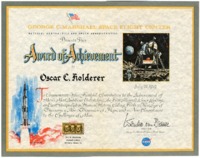
Oscar Holderer Collection
Dublin Core
Identifier
Oscar Holderer Collection
Title
Oscar Holderer Collection
Description
Oscar Holderer was born on November 4, 1919 in Pruem, Germany. His mother's name was Helene. His father Richard Holderer was a surveyor for the German Government, and his younger brother Erich died in battle in Russia. His sister had two children, Axel and Thea.
Oscar Holderer studied Mechanical Engineering at the University of Berlin. He married Inge Spors in Berlin on February 20, 1943, and in the same year, he was transferred to Peenemünde by the German Army to work on the V-2 rocket. While on this project, he designed an airbrake to retrieve experimental V2 versions and servo drives for the WASSERFALL antiaircraft rocket.
In 1945, Holderer joined the 120 team members working under Wernher von Braun for the US Army in the USA, initially in Fort Bliss, Texas. The next year, his mother, his wife, and his son Thomas, born January 18, 1945, joined him in the USA. In 1950, the family moved to Huntsville, Alabama, and on February 1, 1953, Holderer's son Michael was born.
In 1960, NASA officially became Holderer's employer. While working in the USA, Holderer contributed to rocketry and space flight programs. He designed transporters and test hardware for the Redstone and Pershing missiles and specialized in developing and engineering experimental aerodynamic hardware. His largest project was the design of the 14" trisonic wind tunnel, for which he was granted several U.S. Patents and a Meritorious Civil Service Award.
He retired from NASA in 1974 and worked for the Alabama Space Science Commission until 2005. During this time, he designed most of the simulators used in Space Camp USA, Huntsville, Alabama. Holderer's sons Thomas and Michael became engineers. Oscar Holderer has four grandchildren: Sarah, Erich, Melani, and Daniel. In 1993, Holderer's wife Inge died, and Holderer was remarried to Jan Dunlap in 1995. Jan's two children from her previous marriage, Clifford Dunlap and Mary Gaither, live in the Huntsville area.
Holderer died on May 5, 2015.
Oscar Holderer studied Mechanical Engineering at the University of Berlin. He married Inge Spors in Berlin on February 20, 1943, and in the same year, he was transferred to Peenemünde by the German Army to work on the V-2 rocket. While on this project, he designed an airbrake to retrieve experimental V2 versions and servo drives for the WASSERFALL antiaircraft rocket.
In 1945, Holderer joined the 120 team members working under Wernher von Braun for the US Army in the USA, initially in Fort Bliss, Texas. The next year, his mother, his wife, and his son Thomas, born January 18, 1945, joined him in the USA. In 1950, the family moved to Huntsville, Alabama, and on February 1, 1953, Holderer's son Michael was born.
In 1960, NASA officially became Holderer's employer. While working in the USA, Holderer contributed to rocketry and space flight programs. He designed transporters and test hardware for the Redstone and Pershing missiles and specialized in developing and engineering experimental aerodynamic hardware. His largest project was the design of the 14" trisonic wind tunnel, for which he was granted several U.S. Patents and a Meritorious Civil Service Award.
He retired from NASA in 1974 and worked for the Alabama Space Science Commission until 2005. During this time, he designed most of the simulators used in Space Camp USA, Huntsville, Alabama. Holderer's sons Thomas and Michael became engineers. Oscar Holderer has four grandchildren: Sarah, Erich, Melani, and Daniel. In 1993, Holderer's wife Inge died, and Holderer was remarried to Jan Dunlap in 1995. Jan's two children from her previous marriage, Clifford Dunlap and Mary Gaither, live in the Huntsville area.
Holderer died on May 5, 2015.
Collection Tree
- Space Collections
- Oscar Holderer Collection
